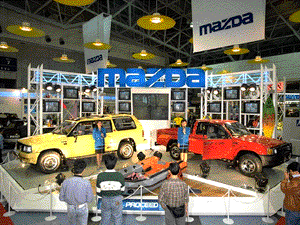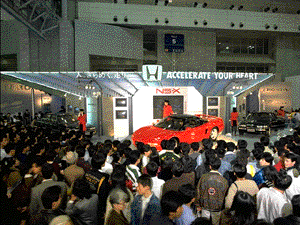 |
 |
 |
The
28th Tokyo Motor Show (1989
. 10/26 - 11/6)
 |
 |
| The 28th Tokyo Motor Show Poster |
"Freedom of Mobility - A Taste of Real Life and Luxury"
The year 1989 marked a milestone in Japanese history:
the change of era from Showa to Heisei. The world economy
had been dismayed by the collapse of stock markets starting
with Wall Street two years earlier. However, the Japanese
economy, which had been forecast to shift from high growth
(annual growth of GNP 4.6% during 1975-82) to maturity
(4% during 1983-87), continued to grow. The fourth consecutive
year of boom which appeared to approach the record 42-month
"Iwato Boom" came amidst the "bubble economy," when the
increased value land and stock created "new rich" who
pushed up personal consumption, especially through remodeling
of their homes and purchase of priced commodities. Clothes,
jewels, and paintings sold well at department stores.
In the automobile market, models were diverse and high-priced
cars sold well. Thus, abundance in consumer society shifted
from quantity to quality. One consequence of this change
was the young people s tendency to avoid "3K"- kiken (dangerous),
kitsui (tough) and kitanai (dirty) - jobs. A life style
called "free arbeiter (freelance)" appeared. Industry
suffered constant labor shortages, offering 1.45 positions
for every person seeking work and as many as 4.0 for part-timers.
It was overseas laborers that filled this shortage.
|
 |
 |
 |
Wealth boosted vehicle demand. Domestic vehicle demand in 1987 and 1988 grew an annual 8-10%. Passenger car sales grew 30.7% in 1989. This was due tothe lowering of car prices relative to per capita national income. Replacing the commodity tax with a consumption tax also pushed prices downward, and the increasing multi-car ownership caused by a shift to individual style further encouaged sales. Labor shortage coupled with increased demand caused an extreme shortage of vehicles. In response to this, the auto industry actively built new plants and enlarged or automated existing ones to cope with labor shortage and the shortening of working hours.
From the 28th show, the showplace was moved to the Nippon Convention Center (a permanent international exhibition ground - known as "Makuhari Messe).Why was the showplace moved to Makuhari when Harumi had been the familiar venuefor 22 shows? Because visitors were exceeding 1.2 million due to the expansionof vehicular society. In addition, overseas requests to participate were in-creasing as Japan became internationalized. The Harumi Fair Ground was too small and its facilities were worn from overuse. Road traffic around it was heavy and regulations strengthened. A movement by nearby residents to oppose gatherings of large crowds became more intense. Thus, Harumi was no longer a suitable site for the motor show in terms of from size and environment, not to mention its suitability for an international show. Meanwhile, Makuhari Messe, like Yokohama, is positioned in the outskirts of Metropolitan Tokyo. It is located between the center of Tokyo and the Narita International Airport, 30 minutes from either. This international-scale showplace consists of a main half-cylindrical exhibition hall, a round multipurpose hall, and various conference halls. It is particularly suitable for a motor show because of its 54,000 sq.m. of exhibition space, which can be flexibly divided or consolidated into 8 pillar less units, 6,750 sq.m. each. Thus, the location, scale and facilities of Makuhari satisfied conditions needed for an international exchange center of people, products and information. The new showplace, like other international show ground, was provided with permanent parking areas. It could park 26,000 vehicles on show days, while Harumi was inaccessible by car. Of course, Makuhari was also accessible by mass transportation such as JR train, bus or shuttle bus. Six hotels and shopping centers were planned in the vicinity for visitors from overseas.
|
 |
|
|
|